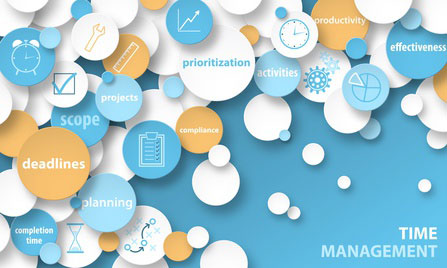As an executive, managing your time properly is one of the most challenging issues you face. After all, time is a precious commodity. Once it’s spent, it’s gone!
Time famine or not having enough time challenges even the most seasoned executive. We all feel overwhelmed whenever there are more tasks than hours. Most executives complain that they don’t know where the time goes. It’s a vicious cycle: you can’t manage your time because you have no time for time management! In order to save time, you need manage your time.
The solution is to use time management tools to accomplish more in less time. Following are six time management tools that have proven to be successful:
Tool #1-Separate the Vital Few from the Trivial Many
Before you take any steps to change your habits, first you need to have a solid understanding about where you should be spending your time. What are your most vital tasks? Think about the following questions:
- What actions have the most impact for your company?
- What are the action items that will have the biggest impact on your career?
- Which daily tasks contribute to the bottom line?
- Which tasks can you put on a “do not do task” list?
As you write your answers decide the trivial tasks that siphon away your time versus the vital tasks that make a difference.
Tool #2-Delegate, Delegate, Delegate!
Let’s face it: you can’t be everything to everyone. Nor should you have to be! You were hired to your executive position for a reason, because there is something valuable that you, and you alone, bring to the table.
Ask yourself before taking on a task “could this task be done by someone else on my team?” What is it that you need to do, that only you can do? Do that! Everything else, delegate! Delegating to your team, provides an opportunity for them to grow and develop.
Tool #3-Quick 10 Minute Roundup
Make a habit of meeting with your assistant every morning for 10 minutes to go over the priorities for the day. This way you’ll be on the same page and they can keep you up to speed on the projects you’re overseeing.
At the end of each week, do a quick 10 minute wrap up. Make sure that tasks were completed or that issues are addressed and get your mind prepared for the next week
Tool #4-The Ongoing Six
Make a list of the six most important tasks that you’ll need to work on tomorrow. These tasks should fall under the umbrella of “If I get these done, I’m making the biggest contribution to the company and my career.”
The next morning, those are the tasks you need to work on first. When you review at the end of the day, check off the tasks you were able to finish and add more so that you constantly have six on your list. It takes a lot of energy to keep mental track of tasks and due dates. Don’t hold on to those, write them down.
Tool #5-Make An Appointment With Yourself!
As an executive you’re working constantly, your mind is going 24/7, filled with work tasks, deadlines, meetings, lunches. When do you have time for personal thinking and reflection?
Well, make time! This is time to work on your own “to do” items that are important but not urgent. These are the tasks and projects that are important to you, your team, and especially your boss that continually are postponed.
Experiment with time and place! Some executives make an appointment with themselves before work at Starbucks others may use 1 or 2 lunches during the week. Find what works for you!
Tool #6-Audit Time Expenditures
Ever felt like you’ve been sitting in meetings all day but getting nothing done? Time to audit your meeting schedule! Meetings are notorious for eating up time and productivity.
Take a look at your quarterly meeting schedule. Decide which meetings you want to be at and which you can delegate to someone on your team. Meetings that include other executive or your boss should be definite for you to attend. What is the purpose of the meeting? If decisions are being made, important information to be shared, or political reasons, keep it on your schedule.
However, if many people are invited or the purpose of the meeting is to review the status of project, consider sending a member of your team. Ask the person attending for a summary report after the meeting. Also, attending meetings provides the opportunity for team members to interact with other executives.
Periodically do a time audit. On your calendar, keep track of down what happened during the those invisible time wasters: long phone calls, interruptions, being asked to do projects that aren’t appropriate.
The Path to The Bottom Line
Start now! Implement these six tools and you will see how time famine begins to lessen while your productivity begins to expand.
Continued Success!



